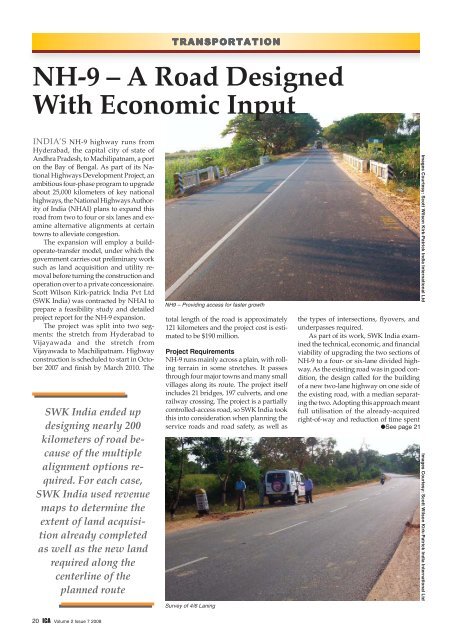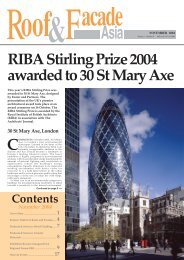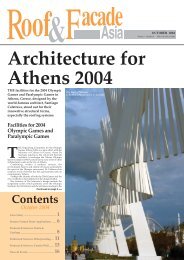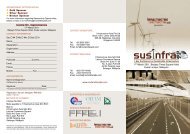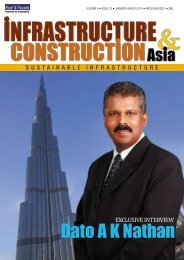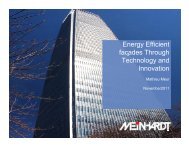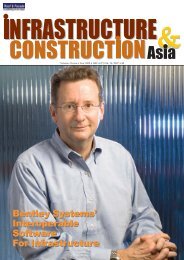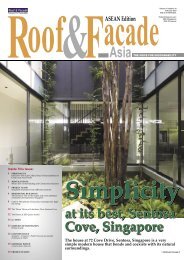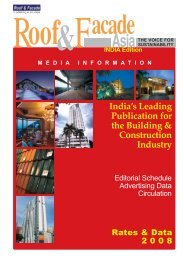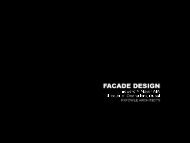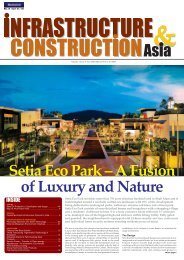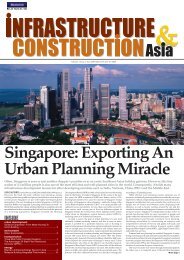Yangtze River Tunnel â A Project Of E&C ... - Roof & Facade
Yangtze River Tunnel â A Project Of E&C ... - Roof & Facade
Yangtze River Tunnel â A Project Of E&C ... - Roof & Facade
Create successful ePaper yourself
Turn your PDF publications into a flip-book with our unique Google optimized e-Paper software.
Image Courtesy:Bentley Systems Inc<br />
TECHNOLOGY & COMMUNICATIONS<br />
structure (13.65 meters by 150 meters by<br />
132.65 meters). The substructure includes<br />
twin circular piers on a large-diameter<br />
deep caisson double D-shaped well foundation.<br />
The bridge’s superstructure is conceived<br />
as a trussed arch that follows the<br />
bending moment profile. The two planes<br />
of the truss are placed 12.1 meters apart<br />
to provide two broad-gauge railway lines<br />
at the bottom level of the superstructure.<br />
The truss planes are connected together<br />
through cross girders and lateral<br />
bracings at the top, bottom and middle<br />
levels.<br />
Efficiency of 3D Analysis<br />
The superstructure weighs 6,000 tons<br />
and contains more than 11,000 members.<br />
RITES used Bentley’s STAAD.Pro and<br />
MXRAIL to create a 3D beam model of<br />
the superstructure and design of the<br />
alignment, respectively. RITES used the<br />
3D models to analyse the effects of various<br />
loads, with the entire design and<br />
analysis carried out in accordance with<br />
prevailing code provisions.<br />
In the preliminary design stage, the<br />
truss arch design was optimised so that<br />
stress flows in a controlled manner. The<br />
graphical output of STAAD.Pro helped<br />
perform this task effectively. The solution<br />
also helped engineers calculate secondary<br />
stresses, eliminating the need to prestress<br />
the members.<br />
The input/output graphics of<br />
STAAD.Pro proved immensely helpful<br />
during this process. For example, the effects<br />
of rigid and semi-rigid joints were<br />
analysed for stress relief to the bottom<br />
floor system. The bracing system and<br />
joints were modelled using user-defined<br />
support commands to study the effects<br />
of rigid connection.<br />
Stringer to cross-girder connections<br />
must be flexible in order to minimise inbuilt<br />
and longitudinal stresses. As a result,<br />
stringers were released for longitudinal<br />
forces at one end to minimise the<br />
effect of longitudinal movement and<br />
maximise flexibility.<br />
Engineers also used customisable<br />
report-generation tools of STAAD.Pro<br />
to generate final submissions, which<br />
were proof-checked and submitted to<br />
the client well within the time scheduled.<br />
It is claimed that use of<br />
STAAD.Pro will save man-months in<br />
design time. Through optimising the<br />
design, the firm would cut steel requirement<br />
for the superstructure by 15<br />
percent alone, or about 1,000 tons.<br />
The New Jubilee Bridge is currently<br />
under construction, with an estimated<br />
cost of $30 million and is expected to be<br />
commissioned by 2010. ICA<br />
PROJECT CREDITS:<br />
Consultancy, Design & Supervision:<br />
RITES Ltd<br />
Client: Indian Railways<br />
Software: Bentley Systems Inc.<br />
●From page 10<br />
studies and design, taking into account<br />
development in the built-up area around<br />
the approaches and the river hydraulics.<br />
Eastern Railways requested that the<br />
profile of the New Jubilee Bridge’s superstructure<br />
coexist with the existing<br />
bridge, which will be declared a historical<br />
landmark. Used for the first time on<br />
an Indian railway, the RITES design incorporates<br />
a 415.6-meter three-span railway<br />
bridge with a continuous super-<br />
RITES designed a new railway bridge in harmony with the Replaced Victorian-era bridge<br />
Volume 2 Issue 7 2008 ICA 11


